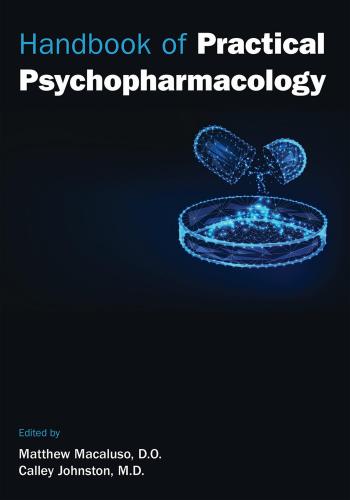Handbook Of Practical Psychopharmacology
| Item Information | |
|---|---|
| Item#: | 9781615374878 |
| Author | Macaluso & Johnston |
More than 130 medications are represented in this new Handbook of Practical Psychopharmacology. Intended as a quick-reference tool for clinicians, trainees, and other practitioners, it is rich in high-yield, evidence-based, and easily accessible information for commonly prescribed psychopharmacological agents, including antidepressants, antipsychotics, stimulants, mood stabilizers, and nutraceuticals/phytoceuticals.
For each medication covered, readers will find concise, easily referenced information on • Indications• Contraindications• Dosing• Drug interactions• Clinical monitoring• Adverse effects
Conveniently organized by drug class and indication, the handbook also features clinical pearls for each agent and class from experts and published literature in the field. Readers will benefit from evidence-based information on off-label prescribing, as well as from sections devoted to prescribing in special situations (e.g., pregnancy and lactation) and in specific populations (e.g., older adults and children/adolescents).
As useful as a teaching tool and study guide as it is as an on-the-spot resource in outpatient, inpatient, and emergency settings, the Handbook of Practical Psychopharmacology is the busy practitioner's must-have companion.
This book features easily accessible information on indications, contraindications, dosing, drug interactions, clinical monitoring, and adverse effects for more than 130 medications, including antidepressants, antipsychotics, mood stabilizers, nutraceuticals/phytoceuticals, and more.
Table of ContentsChapter 1. Basic principles of pharmacology Chapter 2. Alphabetical listing of where to find specific medications in the pocket guide Chapter 3. Antidepressant medications Chapter 4. Anti-anxiety medicationsChapter 5. Mood stabilizersChapter 6. Antipsychotic medicationsChapter 7. Stimulant medicationsChapter 8. Hypnotic medicationsChapter 9. Medications for neurocognitive disordersChapter 10. Medications for treating eating disordersChapter 11. Medications for treating substance use disordersChapter 12. Medications for agitationChapter 13. Rescue medications for treating adverse effects of other medicationsChapter 14. Special considerations

